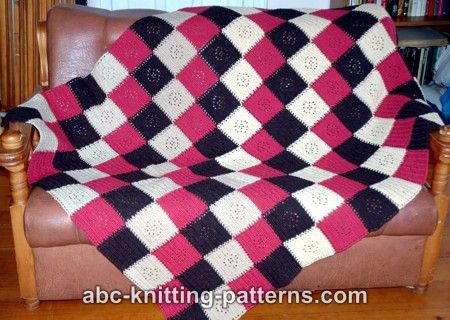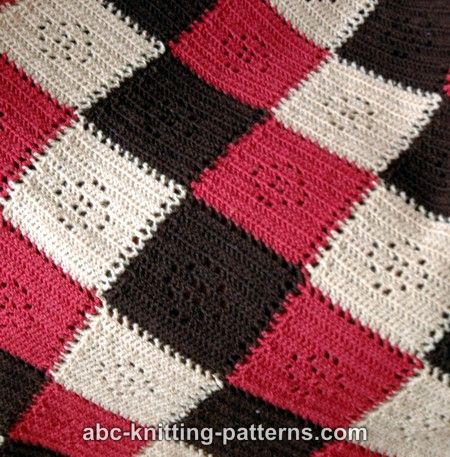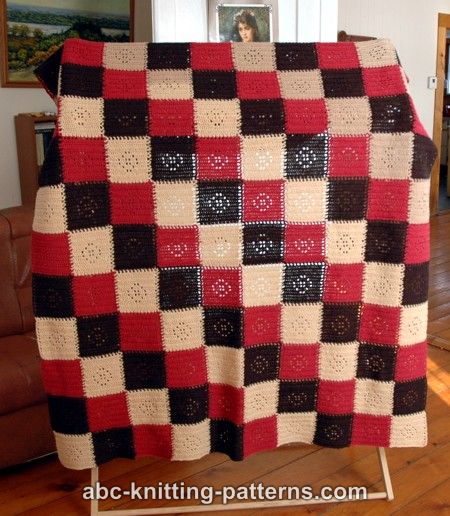



 Intermediate
IntermediateFree Afghan Crochet Pattern
Although this throw looks like a traditional design that consists of separate square motif combined into a blanket, it is not! It is actually crocheted seamlessly. This gives it a smooth look, and is also faster once you are used to it.
The blocks feature a simple filet crochet motif. It can be easily adapted for other filet crochet motifs, which you should feel free to do if you are a more experienced crocheter. If people like this concept, I might make more variations of this afghan.
I used 3 yarn colors, but you can use anywhere from 2 to as many as you like.
Size: width - 52" (130 cm), length - 66" (165 cm)
Materials: 100% Wool DK weight yarn 120 yd (110 m)/50g, color Natural – 12 skeins. (C1)
% Wool DK weight yarn 120 yd (110 m)/50g, color Brown – 12 skeins. (C2)
% Wool DK weight yarn 120 yd (110 m)/50g, color Pink – 12 skeins. (C3)
Hook: G (4.00 mm)
Gauge:
Block size : 5.5” wide x 5.00” high (13.75 cm x 12.5 cm)
Abbreviations:
ch = chain
st(s) = stitch(es)
sl st = slip stitch
sc = single crochet
dc = double crochet
2dccl - 2 dc cluster: work 1 dc into the next dc, work 2nd dc into the base of the last dc of the second row of the connecting block
C1 – color 1
C2 – color 2
C3 – color 3
First Block
With C1 yarn
Chain 29.
Row 1: 1 dc into the 6th chain from the hook. 1 dc in each of next 20 ch, ch 1, skip 1, 1 dc in the last ch. Turn.
Row 2: ch 4 (counts as 1 dc and 1 ch), skip 1, 1 dc in each of next 21 dc, ch 1, 1 dc in the 3rd chain of ch-4. Turn.
Row 3: repeat row 2.
Row 4: ch 4 (counts as 1 dc and 1 ch), skip 1, 1 dc in each of next 9 dc, ch 1, skip 1 dc, 1 dc in next dc, ch 1, skip 1 dc, 1 dc in next 9 dc, ch 1, 1 dc in the 3rd chain of ch-4. Turn.
Row 5: ch 4 (counts as 1 dc and 1 ch), skip 1, 1 dc in each of next 7 dc, ch 1, skip 1 dc, 1 dc in next dc, 1 dc in ch-1, 1 dc in next dc, 1 dc in ch-1, 1 dc in next dc, ch 1, skip 1 dc, 1 dc in next 7 dc, ch 1, 1 dc in the 3rd chain of ch-4. Turn.
Row 6: ch 4 (counts as 1 dc and 1 ch), skip 1, 1 dc in each of next 5 dc, ch 1, skip 1 dc, 1 dc in next dc, 1 dc in ch-1, 1 dc in next dc, ch 1, skip 1 dc, 1 dc in next dc, ch 1, skip 1 dc, 1 dc in next dc, 1 dc in ch-1, 1 dc in next dc, ch 1, skip 1 dc, 1 dc in next 5 dc, ch 1, 1 dc in the 3rd chain of ch-4. Turn.
Row 7: repeat row 6.
Row 8: repeat row 5.
Row 9: repeat row 4.
Row 10: ch 4 (counts as 1 dc and 1 ch), skip 1 ch, 1 dc in each of next dc or ch (21 dc), ch 1, 1 dc in the 3rd chain of ch-4. Turn.
Rows 11-12: repeat row 2.
Row 13: ch 4 (counts as 1 dc and 1 ch), skip 1 ch, *1 dc in next dc, ch 1 , skip 1 dc, repeat from *to the end of the row, end with ch 1, 1 dc in the 3rd chain of ch-4. Cut yarn.
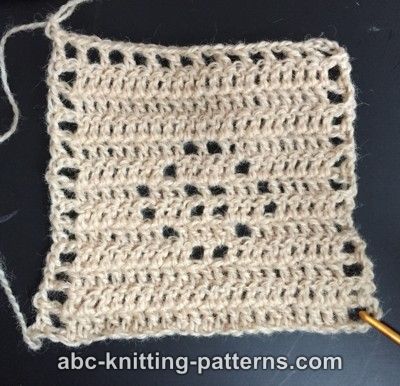
Click image to enlarge
Connected Block
With C2 yarn
Secure the yarn to the beginning of Row 1 of the First Block (see picture). Chain 29.
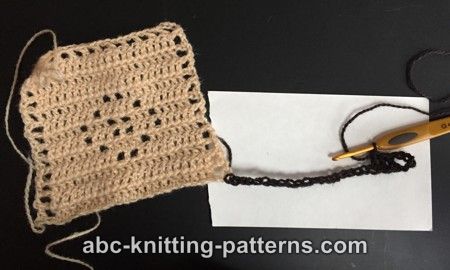
Row 1: 1 dc into the 6th chain from the hook. 1 dc in each of next 19 ch, 2dccl (2 dc cluster: work 1 dc into the next dc, work 2nd dc into the base of the last dc of the second row of the connecting block), ch 1, 1 dc into the 2nd ch of the ch-4 of the 3rd row of the connecting block (1 ch and the top of the last dc counts as the 1st dc of the next row). Turn.
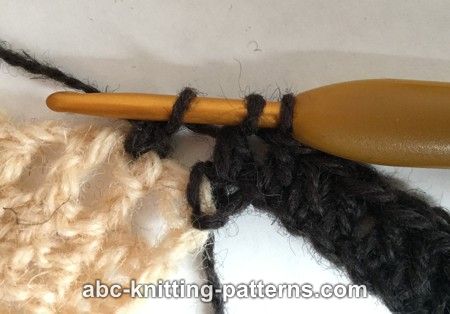
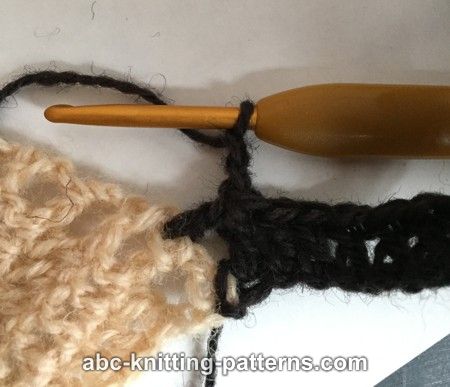
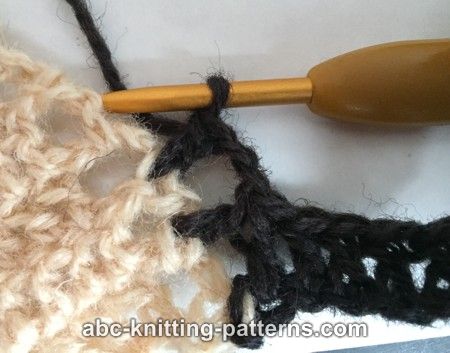
Row 2: 1 dc in each of next 20 dc, ch 1, 1 dc in the 3rd chain of ch-4. Turn.
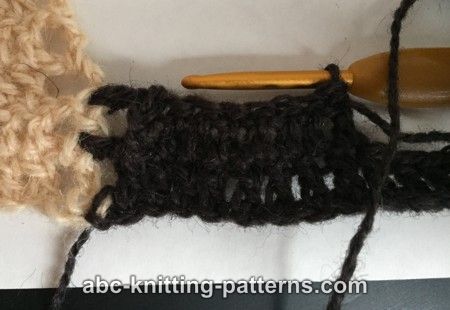
Row 3: ch 4 (counts as 1 dc and 1 ch), skip 1, 1 dc in each of next 20 dc, 2dccl (2 dc cluster: work 1 dc into the next dc, work 2nd dc into the base of the last dc of the 4th row of the connecting block), ch 1, 1 dc into the 2nd ch of the ch-4 of the 5th row of the connecting block (1 ch and the top of the last dc counts as the 1st dc of the next row). Turn.
Row 4: 1 dc in each of next 8 dc, ch 1, skip 1 dc, 1 dc in next dc, ch 1, skip 1 dc, 1 dc in next 9 dc, ch 1, 1 dc in the 3rd chain of ch-4. Turn.
Row 5: ch 4 (counts as 1 dc and 1 ch), skip 1, 1 dc in each of next 7 dc, ch 1, skip 1 dc, 1 dc in next dc, 1 dc in ch-1, 1 dc in next dc, 1 dc in ch-1, 1 dc in next dc, ch 1, skip 1 dc, 1 dc in next 6 dc, 2dccl (2 dc cluster: work 1 dc into the next dc, work 2nd dc into the base of the last dc of the 6th row of the connecting block), ch 1, 1 dc into the 2nd ch of the ch-4 of the 7th row of the connecting block (1 ch and the top of the last dc counts as the 1st dc of the next row). Turn.
Row 6: 1 dc in each of next 4 dc, ch 1, skip 1 dc, 1 dc in next dc, 1 dc in ch-1, 1 dc in next dc, ch 1, skip 1 dc, 1 dc in next dc, ch 1, skip 1 dc, 1 dc in next dc, 1 dc in ch-1, 1 dc in next dc, ch 1, skip 1 dc, 1 dc in next 5 dc, ch 1, 1 dc in the 3rd chain of ch-4. Turn.
Row 7: ch 4 (counts as 1 dc and 1 ch), skip 1, 1 dc in each of next 5 dc, ch 1, skip 1 dc, 1 dc in next dc, 1 dc in ch-1, 1 dc in next dc, ch 1, skip 1 dc, 1 dc in next dc, ch 1, skip 1 dc, 1 dc in next dc, 1 dc in ch-1, 1 dc in next dc, ch 1, skip 1 dc, 1 dc in next 4 dc, 2dccl (2 dc cluster: work 1 dc into the next dc, work 2nd dc into the base of the last dc of the 8th row of the connecting block), ch 1, 1 dc into the 2nd ch of the ch-4 of the 9th row of the connecting block (1 ch and the top of the last dc counts as the 1st dc of the next row). Turn.
Row 8: 1 dc in each of next 6 dc, ch 1, skip 1 dc, 1 dc in next dc, 1 dc in ch-1, 1 dc in next dc, 1 dc in ch-1, 1 dc in next dc, ch 1, skip 1 dc, 1 dc in next 7 dc, ch 1, 1 dc in the 3rd chain of ch-4. Turn.
Row 9: ch 4 (counts as 1 dc and 1 ch), skip 1, 1 dc in each of next 9 dc, ch 1, skip 1 dc, 1 dc in next dc, ch 1, skip 1 dc, 1 dc in next 8 dc, 2dccl (2 dc cluster: work 1 dc into the next dc, work 2nd dc into the base of the last dc of the 10th row of the connecting block), ch 1, 1 dc into the 2nd ch of the ch-4 of the 11th row of the connecting block (1 ch and the top of the last dc counts as the 1st dc of the next row). Turn.
Row 10: 1 dc in each of next dc or ch (20 dc), ch 1, 1 dc in the 3rd chain of ch-4. Turn.
Row 11: repeat row 3.
Row 12: repeat row 2.
Row 13: ch 4 (counts as 1 dc and 1 ch), skip 1 ch, *1 dc in next dc, ch 1 , skip 1 dc, repeat from *to the last dc of the prev row, end with ch 1, sl st to the ch-4 of the last row of the connecting block.
This is the end of the connecting block and the beginning of the next block (another connected block, or the top block, if you have reached the top edge of the afghan).
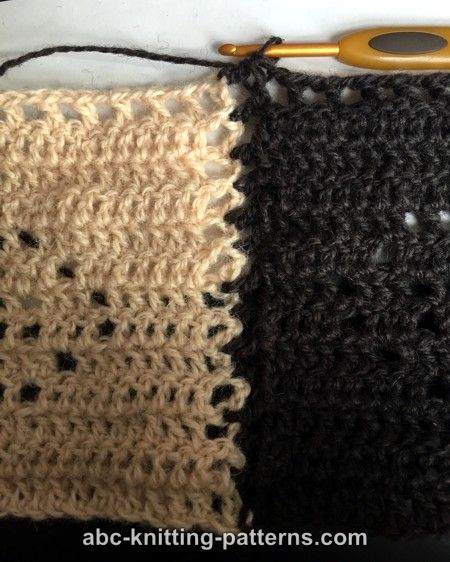
Top Block
The top block is identical to the first block. The only difference is in Row 1: in the top block, the base of row 1 is not a chain, but the last row of the block below.
With C2 yarn
Row 1: ch 4 (counts as 1 dc and 1 ch), 1 dc in each of next dc or ch (21 dc), ch 1, skip 1, 1 dc in the last ch. Turn.
Row 2-13, as in First Block.
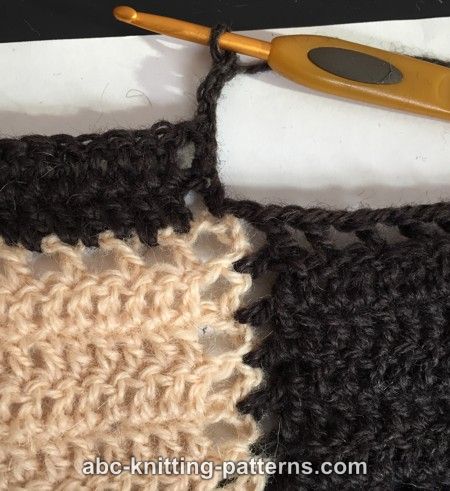
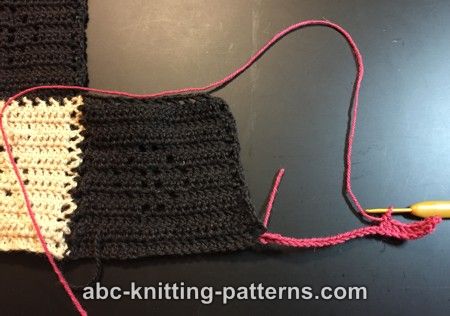
Click image to enlarge
Throw
With C1 yarn, work the First Block, cut yarn.
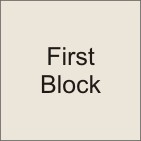
With C2, starting from the beginning of the First Block, work the Connecting Block. After it is completed, continue to work the Top Block with the same yarn color. Cut yarn. The 2nd diagonal is completed (the 1st being the First Block).
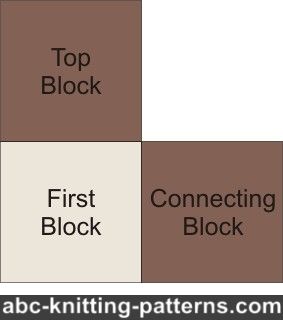
With C3, starting from the beginning of the Connecting Block, work another Connecting Block. After it is completed, continue to work another Connecting Block, and then the Top Block. Cut yarn. The 3rd diagonal is completed.
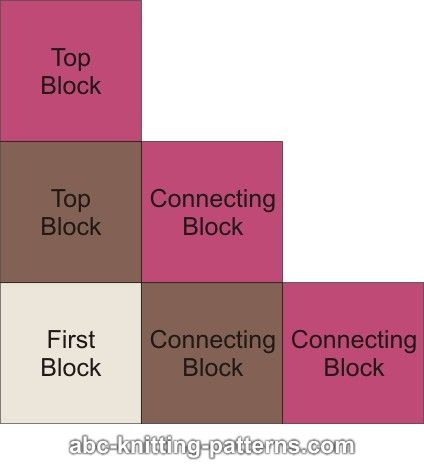
Continue to work as established, until you achieve the desired width of the throw.
Now, start all further diagonals not with the chain, but on top of the 1st block of the previous diagonal.
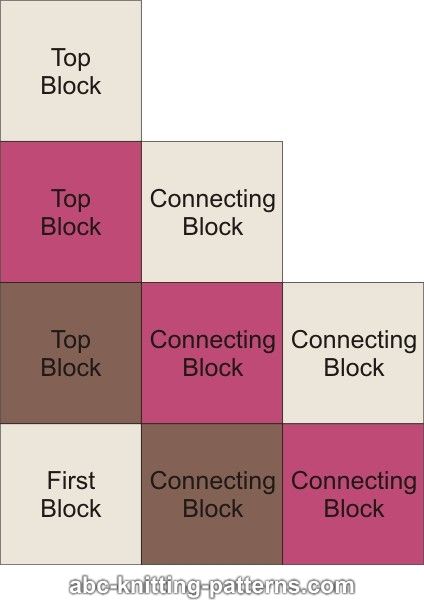
Work as established, until you achieve the desired length of the throw. After this, stop working the Top Block at the end of every diagonal, cut yarn after the last Connecting Block in each diagonal. The number of Connecting Blocks in every next diagonal will be decreased by 1 as established. Work as established until you work the last Connecting Block. Cut yarn.
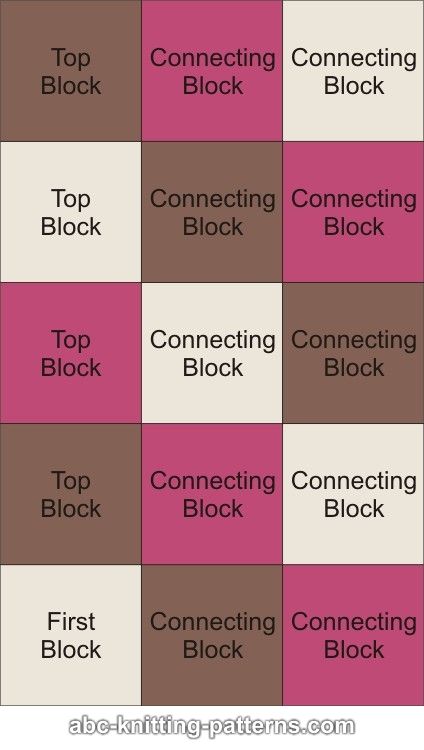
Finishing
Block the throw.
